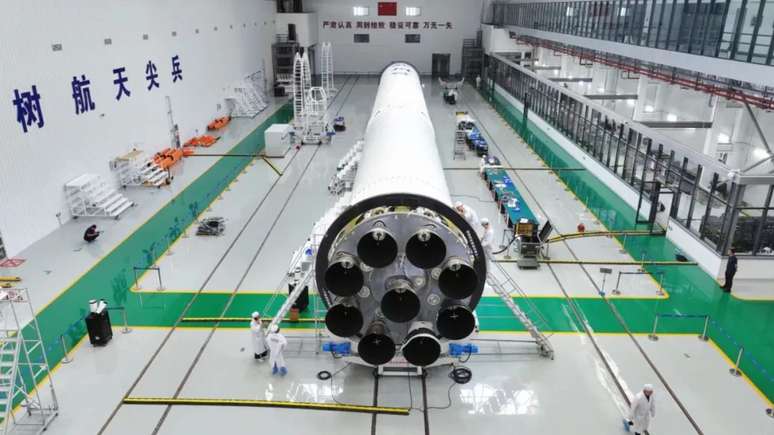During tests of the first stage of the Space Pioneer rocket, the equipment broke away from the launch pad and accidentally flew off, hitting the hills
OR Chinese rocket Tianlong-3, from the commercial company Space Pioneer, suffered a failure during firing tests and crashed last Sunday (30), after being launched accidentally. The accident occurred at China’s Gongyi testing facility in Henan province.
- China’s ‘sister’ rocket to the Falcon 9 could launch in 2024
- China plans to conduct more than 70 commercial and state-run launches this year
In amateur footage taken by the civilian population it is possible to see the first rocket stage of nine engines fires and suddenly takes off, until it stops—apparently cutting its engines—and falls horizontally into the mountains. Clamps typically hold rockets in place, especially in a static firing test, as this one was supposed to be.
The Tianlong-3 first stage hit the ground about 50 seconds after launch, exploding the oxygen fuel in the liquid kerosene in a large cloud of fire and smoke. The authorities of Henan province informed the Shanghai digital newspaper The paper that there were no injuries, as the population had been evacuated from the site before the tests.
The Tianlong-3 accident
Space Pioneer – which may also be called Beijing Tianbing Technology – released a statement reporting a structural failure in the connection between the body of the rocket and the evidence base.
Wow. This is apparently what a STATIC TEST FIRE of a Tianlong-3 first stage by Space Pioneer was supposed to be today. It’s catastrophic, not static. The company was aiming for an orbital launch in the next few months. https://t.co/BY9MgJeE7A pic.twitter.com/L6ronwLW1N
—Andrew Jones (@AJ_FI) June 30, 2024
The Tianlong-3’s on-board computer automatically shuts down the engines after the accidental release, causing the rocket to crash about 1.5 km southwest of the launch site. According to the company, 850 tons of propellant were burned.
Due to this accident, the planned orbital launch of the Tianlong-3 project is expected to be delayed: the test is expected to be carried out at the Wenchang spaceport on Hainan Island. Space Pioneer was the first in the country to achieve a commercial launch into orbit with Tianlong-2, launched in 2023, according to Chinese state media.
Another view here. We must hope that there are no victims. This is absolutely insane. And Space Pioneer has already reached orbit with Tianlong-2, so this is simply baffling. https://t.co/QlQT13FNtI pic.twitter.com/F58tJhVoRJ
—Andrew Jones (@AJ_FI) June 30, 2024
The Tianlong-3 is much larger than its predecessor, measuring 3.8 meters in diameter and having a take-off weight of 590 tonnes, being capable of carrying 17 tonnes of cargo to the ground. low earth orbit. The performance is comparable to that of the Falcon-9 rocket, from SpaceX. The accident occurred shortly after Chinese success from Chang’e-6, which retrieved samples from the far side of the moon.
Source: Space pioneer, The paper
Trends on Canaltech:
- ‘Severe’ Solar Storm Hits Earth, Surprises Scientists
- Festival Parintins 2024 | Where to watch the broadcast on TV and Internet
- The 50 Funniest Google Assistant Jokes
- The 20 best horror films of the new generation
- S3xo em*rte | Why do people write code on Instagram?
- AstraZeneca ‘admits’ rare side effect of Covid-19 vaccine
Source: Terra
Rose James is a Gossipify movie and series reviewer known for her in-depth analysis and unique perspective on the latest releases. With a background in film studies, she provides engaging and informative reviews, and keeps readers up to date with industry trends and emerging talents.






